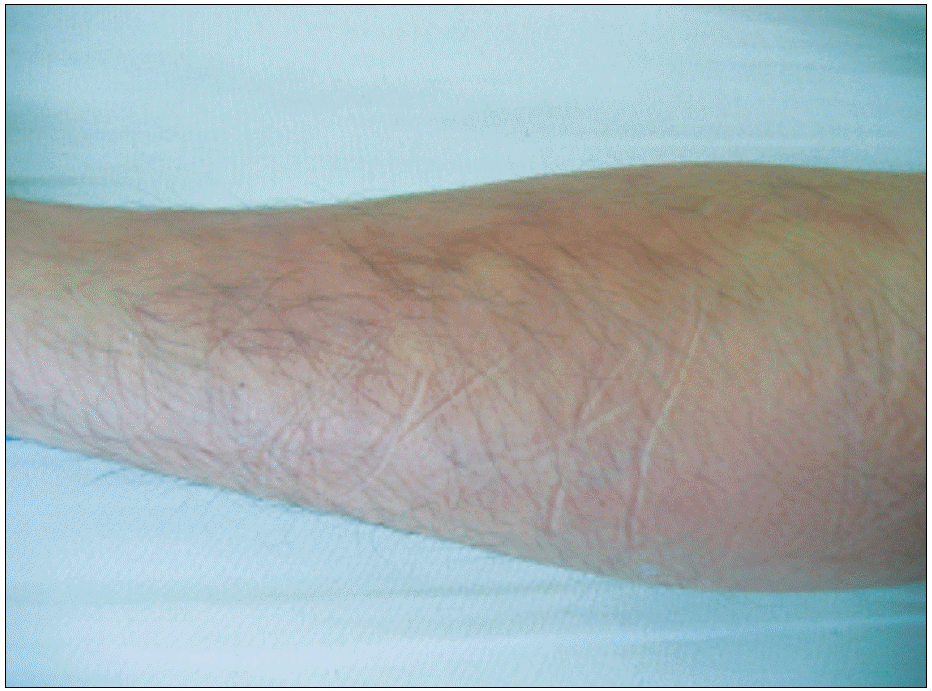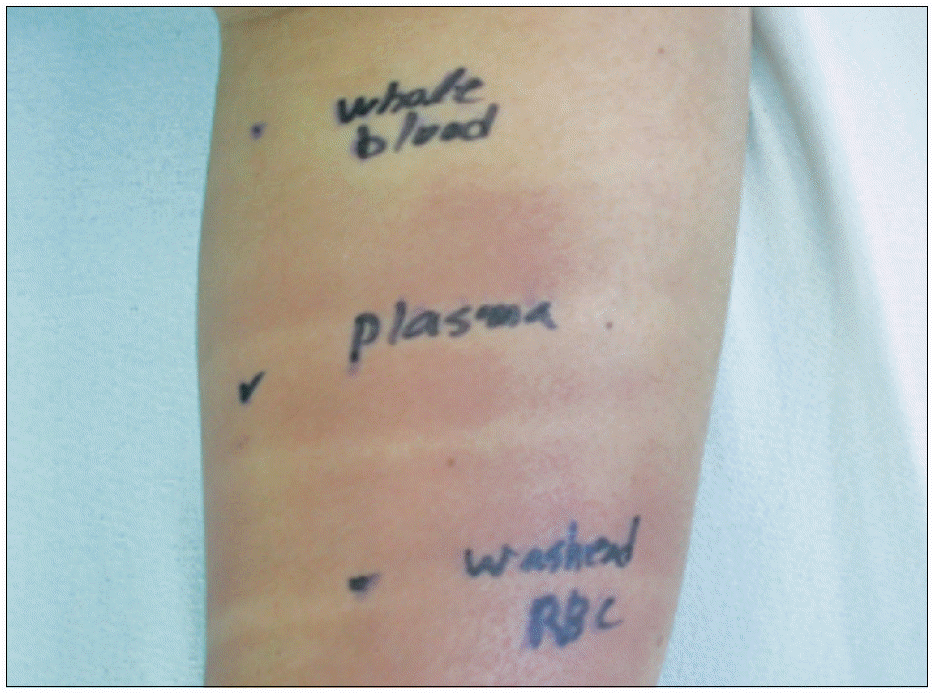Abstract
Autoerythrocyte sensitization syndrome (Gardner-Diamond syndrome), also known as painful bruising syndrome or psychogenic purpura, is characterized by sudden and spontaneous painful bruising and swelling on both extremities, and is a psychologically induced painful bruising condition. The exact etiology of the syndrome is an enigma, even today. It occurs primarily in young to middle-aged women who usually have psychogenic disorders. A diagnosis of this syndrome is made on the basis of the clinical history, dermatological examination complemented by a positive autoerythrocyte sensitization test, psychiatric evaluation and the absence of any organic cause. We present a 20-year-old man with characteristic features of this syndrome, who had a positive autoerythrocyte sensitization test. To our knowledge, this is the first case in an adult male reported in the Korean literature.
REFERENCES
1). Gardner FH., Diamond LK. Autoerythrocyte sensitization: a form of purpura producing painful bruising following autosensitization to red blood cells in certain women. Blood. 1955. 10:675–90.

2). Ratnoff OD. The psychogenic purpuras: a review of autoerythrocyte sensitization, autosensitization to DNA, “hysterical” and factitial bleeding, and the religious stigmata. Semin Hematol. 1980. 17:192–213.
3). Ratnoff OD. Psychogenic purpura (autoerythrocyte sensitization): an unsolved dilemma. Am J Med. 1989. 87:16N–21N.
4). Fey MF., Beck EA. Psychogenic purpura, idiopathic thrombocytopenic purpura, and platelet dysfunction in the same patient. J Clin Psychiatry. 1986. 47:386–7.
5). Sudy E., Urbina F., Vasquez P. Autoerythrocyte sensitization syndrome with positive anticardiolipin antibodies. Br J Dermatol. 1998. 138:367–8.

6). Berman DA., Roenigk HH., Green D. Autoerythrocyte sensitization syndrome (psychogenic purpura). J Am Acad Dermatol. 1992. 27:829–32.

7). Brazzini B., Ghersetich I., Hercogova J., Lotti T. The neuro-immuno-cutaneous-endocrine network: relationship between mind and skin. Dermatol Ther. 2003. 16:123–31.

8). Ingber A., Alcalay J., Feuerman EJ. Autoerythrocyte sensitization (Gardner-Diamond syndrome) in men: a case report and review of the literature. Postgrad Med J. 1985. 61:823–6.

9). Lee H., Hann SK. Autoerythrocyte sensitizaton syndo-rme: a case report. Korean J Dermatol. 1999. 37:1355–7.
10). Lee GC., Kim YG., Kim MK., Yoon TY. Autoerythrocyte sensitization syndrome. Ann Dermatol. 2005. 17:27–9.

11). Tomec RJ., Walsh M., Garcia JC., Jordan PK. Diagnosis of autoerythrocyte sensitization syndrome in the emergency department. Ann Emerg Med. 1989. 18:780–2.

12). Vun YY., Muir J. Periodic painful purpura: fact or factitious? Australas J Dermatol. 2004. 45:58–63.

13). Sawhney MP., Arora G., Arora S., Prakash J. Undiagnosed purpura: a case of autoerythrocyte sensitization syndrome associated with dermatitis artefacta and psedo-ainhum. Indian J Dermatol Venereol Leprol. 2006. 72:379–81.
14). Spiera H., Schwartz AL. Autoerythrocyte sensitization reproductible by both autologous red cells and heterologous DNA. Mt Sinai J Med. 1970. 37:108–11.
15). Anderson JE., DeGoff W., McNamara M. Autoerythrocyte sensitization (psychogenic purpura): a case reoport and reivew of the literature. Pediatr Emerg Care. 1999. 15:47–8.
16). Settle EC Jr. Autoerythrocyte sensitization successfully treated with antidepressants. JAMA. 1983. 250:1749–50.

17). Utman IW., Moukarbel GV., Salman SM., Salem ZM., Taher AT., Khalil IM. Autoerythrocyte sensitization (Gardner-Diamond) syndrome. Eur J Haematol. 2000. 65:144–7.
Table 1.
Results of investigation
Table 2.
Commonly associated complaints in autoerythro cyte sensitization syndrome
Table 3.
Agents associated with positive intradermal res ponse
| Copper |
| Erythrocyte stroma |
| Hemoglobin |
| Histamine |
| Phosphatidylserine |
| Platelets |
| Pregnandiol |
| Purified protein derivative |
| Serotonin |
| Tyramine |
Table 4.
Reported treatments for autoerythrocyte sensitization syndrome




 PDF
PDF ePub
ePub Citation
Citation Print
Print




 XML Download
XML Download